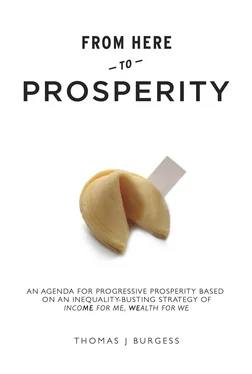Nobel Prize winning economist, Joseph E. Stiglitz explains why this is bad news:
Some people look at income inequality and shrug their shoulders. So what if this person gains and that person loses? What matters, they argue, is not how the pie is divided but the size of the pie. That argument is fundamentally wrong. An economy in which most citizens are doing worse year after year – an economy like America’s is not likely to do well over the long haul.
The Organisation for Economic Co-operation and Development (OECD) warned of sweeping consequences for rich societies in a report in 2011, pointing to the rash of occupations and protests that year, especially by young people, around the world. It said:
Youths who see no future for themselves feel increasingly disenfranchised. They have now been joined by protesters who believe they are bearing the brunt of a crisis for which they have no responsibility, while people on higher incomes appeared to be spared.
Thomas Piketty in his well-researched book, Capitalism in the 21st Century, noted that:
when the rate of return on capital exceeds the rate of growth of output and income, as it did in the 19th century and seems quite likely to again in the 21st century, capitalism automatically generates arbitrary and unsustainable inequalities that radically undermine the meritocratic values on which democratic societies are based.
He does, however, give us hope that:
there are nevertheless ways democracy can regain control over capitalism and ensure that the general interest takes precedence over private interests, while preserving economic openness and avoiding protectionist and nationalist actions.
What is considered the poverty line or threshold varies from country to country depending on the social context. For instance in the USA, the government’s definition of poverty is based on total income received; in 2014 it was set at $23,850 (total yearly income) for a family of four. It is estimated that most Americans will spend at least one year below the poverty line at some point between ages 25 and 75.
In November 2012, the US Census Bureau said more than 16% of the population lived in poverty, including almost 20% of American children, up from 14.3% (approximately 43.6 million) in 2009 and to its highest level since 1993. Starting in the 1980s, relative poverty rates have consistently exceeded those of other wealthy nations. Even in California, the so-called Golden State (from where I have been writing most of this book), after declining to a 20-year low of 12% in 2006, the official poverty rate in California spiked upward in the wake of the Great Recession: as of 2011, it was 16.9%. This amounts to more than six million Californians living in households with incomes below the federal poverty level (about $23,000 for a family of four). The Census ‘Supplemental Poverty Measure’, which incorporates California’s high cost of living and the effect of safety net programs such as food stamps, suggests that California’s poverty rate was even higher at 23.5% during 2009–2011. One third of America’s welfare recipients live in the state, which only comprises 12% (39m) of the USA population (319m): a reality completely out of line with perception.
In the UK, the most common measure of poverty as used in the UK Child Poverty Act 2010, is ‘household income below 60% of median income’. The median income is where half the households earn above the median and half the households earn below the median income level. Though in 2015 the government announced that it would change the definition, which critics say this would show less in poverty whereas many felt that there were in fact more.
In fact governments are pushing working people below the poverty line by taking away hard earned cash through income related taxes, significantly reducing disposable income, then replacing it with tax credits and other welfare benefits, a bizarre merry go round. Employment doesn’t guarantee a life above the poverty line; according to census data, more than one in 10 Americans who work full-time are still poor. In 2013, for the first time, there are more working households living in poverty in the UK than non-working ones, according to the Joseph Rowntree Foundation, the social policy research and development charity. It adds that low pay and part-time work had prompted an unprecedented fall in living standards. This means just over half of the 13 million people in poverty, surviving on less than 60% of the national median (middle) income, were from working families. The Poverty and Social Exclusion project in the UK (PSE), funded by Economic and Social Research Council (ESRC) found that, over the last 30 years, the percentage of households living below society’s minimum standard of living has increased from 14% to 33% – despite the fact that the UK economy has doubled in size over the same period.
We need to solve the causes of economic inequality and poverty; this is not just about getting rid of poverty because unless we reduce economic inequality, poverty will always be there. Nor is it just about redistributing the pot. If wealth were to be used more effectively and not hoarded by the few, this would significantly increase economic growth and it would improve the financial status of a huge number of people. The redistribution of wealth and narrowing of income disparity through the old tax system is not the answer. The solution is more fundamental, a system is needed that does not allow these inequalities to get so vast in the first place; structural and radical changes are required to the capitalist system.
1.2 Slow economic progress
On 25th July 2014, George Osborne, the UK Chancellor of the Exchequer was excited: ‘Thanks to the hard work of the British people, today we reach a major milestone in our long-term economic plan.’ That milestone was that the UK economy had returned to pre-crisis levels by expanding 0.8% in the second quarter of 2014. On an annual basis Gross Domestic Product (GDP) had expanded by 3.1%. The figures showed the economy was then worth 0.2% more than it was at its peak in 2008. (source: Office for National Statistics). This was hollow optimism; it has been very slow progress, with dire consequences for millions of people hit by persistent and ill-conceived austerity measures. So six years of ‘hard work’ many were worse off with stagnant wages and higher prices when in fact a more proactive progressive approach could have meant faster progress and less hardship.
A rise in GDP may be good for a country as a whole but it is only good for its people if they actually benefit, and not just the few. Then after all this time, the UK economy was forecast to be the fastest growing among the G7 developed nations, according to the International Monetary Fund (IMF), predicting that the UK would expand by 3.2% in 2014, up from a previous forecast of 2.8%. But would this mean the people would be better off?
Unemployment had fallen. But there were still not enough jobs or, more importantly, there are not enough jobs that pay a decent, living wage. Meanwhile, the USA reported adding 288,000 jobs in June 2014, making the unemployment rate 6.1%, the lowest since September 2008; not as bad as the most recent high point of 10% in October 2009, but nowhere near the 4.4% rate in May 2007 which was preceded by three years of only ever reaching a maximum of 5.6%. However, these slightly improving figures do not give the whole story, as there was a big shift to part time jobs, which accounted for two thirds of all new jobs in June. More companies are shifting to part-time work as it allows them to avoid paying overtime or health insurance and gives them more flexible options to meet demand.
Even when a person has a job with a decent wage, disposable income is decreasing as living costs rise. In addition, in the UK, the average citizen pays over 50% of his or her income in tax (income and consumption related). So this leaves very little disposable income for most people. The average young family in London in April 2015 only had £347 left a year after essential spending and mortgage payments, according to estate agent Hamptons’ Ability to Buy study, a points-based index which measures house prices, incomes, interest rates and the cost of living. It suggest this was due to a 17% increase in house prices combined with a 9% rise in childcare costs and a 1.6% fall in average incomes.
Читать дальше












